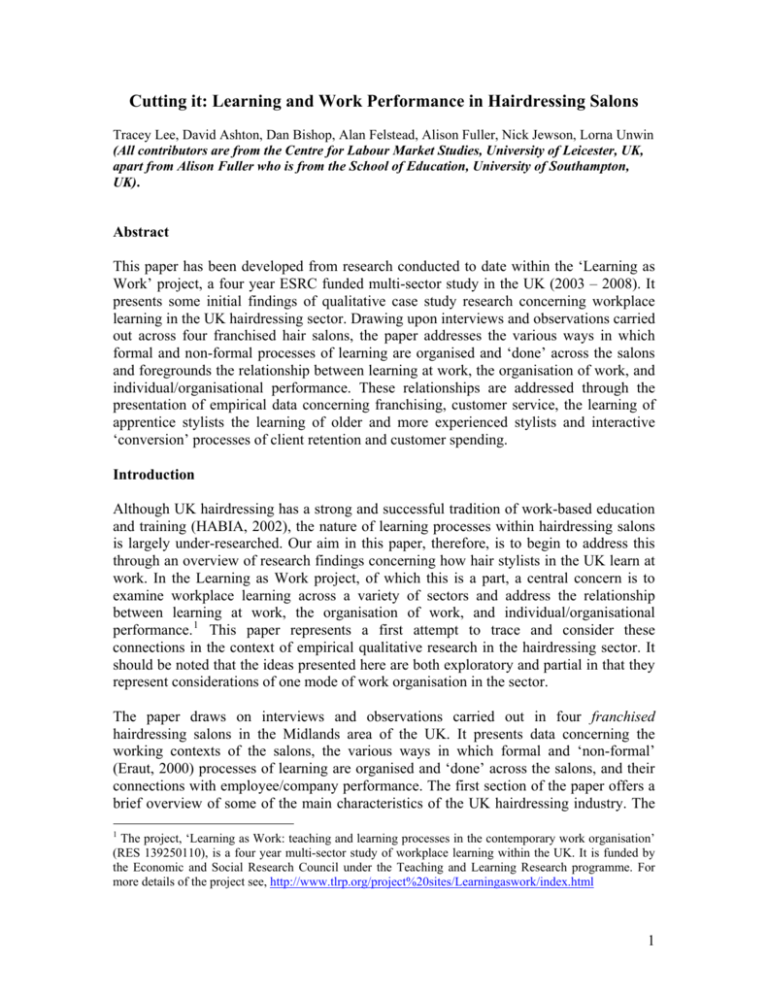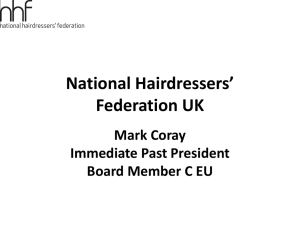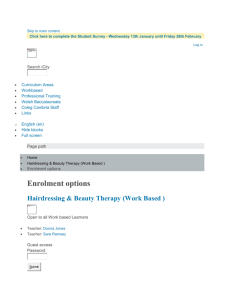Cutting it: Learning and Work Performance in Hairdressing Salons
advertisement

Cutting it: Learning and Work Performance in Hairdressing Salons Tracey Lee, David Ashton, Dan Bishop, Alan Felstead, Alison Fuller, Nick Jewson, Lorna Unwin (All contributors are from the Centre for Labour Market Studies, University of Leicester, UK, apart from Alison Fuller who is from the School of Education, University of Southampton, UK). Abstract This paper has been developed from research conducted to date within the ‘Learning as Work’ project, a four year ESRC funded multi-sector study in the UK (2003 – 2008). It presents some initial findings of qualitative case study research concerning workplace learning in the UK hairdressing sector. Drawing upon interviews and observations carried out across four franchised hair salons, the paper addresses the various ways in which formal and non-formal processes of learning are organised and ‘done’ across the salons and foregrounds the relationship between learning at work, the organisation of work, and individual/organisational performance. These relationships are addressed through the presentation of empirical data concerning franchising, customer service, the learning of apprentice stylists the learning of older and more experienced stylists and interactive ‘conversion’ processes of client retention and customer spending. Introduction Although UK hairdressing has a strong and successful tradition of work-based education and training (HABIA, 2002), the nature of learning processes within hairdressing salons is largely under-researched. Our aim in this paper, therefore, is to begin to address this through an overview of research findings concerning how hair stylists in the UK learn at work. In the Learning as Work project, of which this is a part, a central concern is to examine workplace learning across a variety of sectors and address the relationship between learning at work, the organisation of work, and individual/organisational performance. 1 This paper represents a first attempt to trace and consider these connections in the context of empirical qualitative research in the hairdressing sector. It should be noted that the ideas presented here are both exploratory and partial in that they represent considerations of one mode of work organisation in the sector. The paper draws on interviews and observations carried out in four franchised hairdressing salons in the Midlands area of the UK. It presents data concerning the working contexts of the salons, the various ways in which formal and ‘non-formal’ (Eraut, 2000) processes of learning are organised and ‘done’ across the salons, and their connections with employee/company performance. The first section of the paper offers a brief overview of some of the main characteristics of the UK hairdressing industry. The 1 The project, ‘Learning as Work: teaching and learning processes in the contemporary work organisation’ (RES 139250110), is a four year multi-sector study of workplace learning within the UK. It is funded by the Economic and Social Research Council under the Teaching and Learning Research programme. For more details of the project see, http://www.tlrp.org/project%20sites/Learningaswork/index.html 1 second introduces the case study salons and provides some background information concerning the research process. The findings from the research are presented in the remaining sections following the themes of the organisation of work, learning and performance. The areas covered across these sections are: franchising; customer service; the learning of apprentice stylists; the learning of older, more experienced stylists and the ‘conversion’ processes of client retention and spending. The UK Hairdressing Industry Hairdressing in the UK is a growing industry. According to the Hair and Beauty Industry Authority (HABIA), there are now approximately 36,000 hairdressing salons in the country (compared with 28,590 in 2000) 2 which, in combination with Beauty-related industries, have an annual turnover of over £4 billion; just short of a quarter of a million employees, and generate more than 79 million client visits each year (HABIA, 2002). Although most hairdressing salons tend to be small, independently owned outlets, large salon chains are increasing in number and franchising is a growing feature of the industry (HABIA, 2002). Franchising organisations are associated with high fashion and are known for their innovations in both hairdressing techniques and style (Drucker et al, 2002). They also tend to invest heavily in training, with many running their own ‘inhouse’ training schools and academies (Mintel, 1999). Despite these developments, hairdressing continues to have a reputation for being ‘a simple, unskilled or low-skilled occupation, that can be done by “anybody”’ (Eayrs, 1993). Training provision, both onand-off-the-job is generally considered, however, to be extensive and of high quality. The Training Standards Council, for example, has reported that ‘more good or exceptional provision is found in hairdressing than in any other inspected occupational area (cited in HABIA, 2002). The training for entry into hairdressing is either through apprenticeship schemes or Further Education college courses. Trainees are required to attain a National Vocational Qualification (NVQ) or, in Scotland, an SVQ to at least level 2, which at present is recognised as the minimum qualifying standard. It is currently estimated that out of the total hairdressing workforce 89% of employees hold or are working towards one of these hairdressing qualifications (HABIA, 2004). As an industry, hairdressing is primarily driven by changing fashion and also advances in technology which regularly introduce new hair styling, cutting and colouring techniques and equipment. This requires training providers and also qualified stylists to continually update their skills and knowledge in order to be at the ‘leading edge’ of current hairdressing practice and to respond to changing client demands (HABIA, 2002: 7). The importance of learning within hairdressing is not, therefore, restricted to trainees as ‘legitimate peripheral participants’ (Lave And Wenger, 1991) within salons but is also integral to the work of experienced and qualified stylists. Furthermore, this learning cannot simply be technical in nature. At a time when the demand for high quality services are the highest they have been, customer service and exploiting customer service techniques to maximise profits are becoming increasingly important within the industry. As HABIA (2002: 7) note, ‘this means that besides technical skills, interpersonal skills 2 HABIA (2001) note that their figures are drawn from the Yellow pages Business database and so do not include those salons who do not advertise. 2 are very important, especially the ability to communicate verbally. The service provided is agreed with the client, customised to meet individual needs and delivered straight away. The quality of the service is immediately felt or visible to the client’. Within hairdressing the learning required for successful practice can thus be characterised as both technical and service-oriented which, as suggested by Eayrs (1993: 31) involves two levels of ‘complicated work’. In the remainder of this paper, how the learning of this ‘complicated work’ is organised and connected to both organisational context, performance and conversion processes to increase client retention and spend will be explored. The Case Study Hairdressing Salons The case study salons are franchised from two medium sized organisations. Two of the salons form part of ‘The Haslam Hair Company’ and two are part of the salon group ‘Clarke Anthony’, both based within the Midlands area of England. 3 Interviews were carried out with: directors and managers at the ‘head office’ level of both organisations; the franchisees and salon employees including salon managers, receptionists, senior stylists, stylists, colour technicians (where appropriate), 3rd year ‘junior’ stylists, and 1st and 2nd year apprentices. This paper is based on a total of 38 such interviews, all of which were tape-recorded. They have been transcribed and analysed using Atlas.ti. These interviews were complimented by observations in the salons. These were informal and took place in between interviews and over a one or two day period in each salon. Two training events were formally observed. Both franchising companies are family-owned. The Haslam Hair Company has 30 salons, two of which are company owned. It has been in business for over 30 years, 20 of which have been in franchising. Alongside the salons, the company has two training centres for the off-the-job training of apprentices, and has also developed working partnerships with two local Further Education colleges, providing training in Hair and Beauty. Clarke Anthony has been in business for over 50 years and became a franchising organisation in the late 1980s. It currently has 19 franchised salons and one training centre for the offthe-job training of company apprentices. Both companies can be characterised as offering hairdressing services for women, children and men, in the medium to high price band market. Franchised salons across both companies also have products from well known hairdressing product companies for retail sale. Employees are encouraged to sell these to clients as part of the service and also to increase customer spend. Employees in both companies are employed on a commission basis. Whilst franchised salons across both companies vary in terms of their size and location, those visited as part of the fieldwork are positioned on busy ‘High Street’ areas. Aside from the franchisees the salons have between 10 and 18 staff including receptionists, senior stylists, stylists, colour technicians, 3rd year ‘junior’ stylists, and 1st and 2nd year apprentices. The four salons have a minimum of two apprentices and at least two employees in each salon are newly qualified stylists who are undertaking further training. 3 These are pseudonyms. All names of the franchised salons and associated employers and employees have been changed in order to preserve anonymity. 3 Both companies view NVQ level 2 as providing only a basic level of training and so require that their newly qualified stylists undertake further instruction, by way of a ‘finishing course’, before they can work as ‘qualified’ stylists. The finishing courses are designed to provide them with more in-depth training to ensure that their techniques and service delivery all conform to the standards and specific requirements of the company. 4 Both The Haslam Hair Company and Clarke Anthony thus place considerable emphasis on the need for newly qualifying stylists to learn more than that offered through the NVQ system. However, for both organisations continuous learning and development for older and more experienced employees is also of high priority. The formal and non-formal opportunities for learning available to these employees, as well as trainees, will be discussed later. First, however, we will outline two significant contextual factors that shape these opportunities. The Organisation of Work Franchising A particularly significant feature of both The Haslam Hair Company and Clarke Anthony salons is their organisation and operation as franchised businesses. The franchisees in all four salons are what one director in The Haslam Hair Company head office termed ‘home grown’. They are largely former trainees and employees of other franchised salons of the companies who, through their training and length of service, progressed to senior positions. As a franchisee they pay a monthly fee to the parent company of up to 10% of the salon takings and work on the basis of renewable contracts of approximately 7 years. Particularly notable is that whilst the franchisees are deemed by both themselves and the companies to own their businesses they are required, nonetheless, to conduct their businesses within strict parameters laid out by each parent company. For the franchisees this involves adhering to company policy regarding recruitment, training and staff development, ‘uniforms’ or dress codes for salon staff, and the hair products and equipment to be used and sold within the salon. In addition the franchisees are required to follow salon decoration and fitment guidelines, use company marketing materials, and follow customer related schemes and procedures as promoted by the company. Both the Haslam Hair Company and Clarke Anthony can be thus be characterised as ‘business format franchises’ (Felstead, 1991; 1993) where there is high standardisation and franchisees ‘work in a tightly controlled and highly regulated business relationship’ (Felstead, 1991: 52; 1993). This is considered by the franchisees to be advantageous rather than a drawback. All state that having a franchised salon provides them with business support. For example, they have use of a highly regarded company name with a good reputation under which to trade; the use of a centralised company business system which, via the head office, collates their performance data and oversees their accounting, administration, wages, marketing and IT needs and they have use of a pool of business ‘experts’ to call on for help and advice. Also they state that they have access to good 4 There is a strong sense in the interviews that these standards and requirements are linked to company branding. During an interview with the Business Manager of the Haslam Hair Company, for example, we were informed that the company have their own repertoire of ‘classic cuts’, the number of which far exceed those learned within the NVQ framework, and their own terminology for techniques and styles. 4 quality training, as one franchisee, Claire, from The Haslam Hair Company remarked: ‘you can’t work for a better company, and again it all comes down to those training academies, they are our future business at the end of the day … we’ve got the continual training, the on-going training, the on-going improvement of standards that maybe the independent salons can’t achieve’. The notion of ‘standards’ mentioned here is shown throughout the interviews to be a key feature of the franchising relationship and its operation. As both companies are service sector franchising organisations their standards function as ‘standardised commodities’ insofar as they shape and constitute, at least partially, the service that is sold. However, the requirement for franchisees to therefore ‘all sing from the same standards check sheets’ in order to maintain company coherence brings issues of control very sharply to the fore. Although during the interviews all the franchisees spoke of involvement in company decision making via various formal procedures such as meetings and company focus groups, the organisation of both The Haslam Hair Company and Clarke Anthony was largely ‘top-down’. As highlighted above, high levels of control were exerted by franchisors upon franchisees in terms of business operation. This also extended to salon culture, and to the learning opportunities and processes within the salon. Whilst such control operated through company structures and organisational bureaucracy it also operated through company norms, particularly those of customer service. Customer Service The necessity for excellent customer service and outstanding skills in its provision is a dominant theme running throughout the interviews, both with company directors, franchisees and employees. A key aim for both companies is to provide clients with what one director termed ‘a whole “wow” experience’ through which the company and their employees can be favourably differentiated from others. As Claire from The Haslam Hair Company explains: ‘Well years ago when I came into hairdressing, wowing a client was having a fresh magazine and a nice cup of coffee that wasn’t spilt in the saucer. Now magazines and coffee are an expectation, you know, if somebody isn’t offered a cup of coffee then we’ll have a complaint. So wowing a client is trying to exceed their expectations, doing something that’s different that we hope that they’re going to enjoy and talk about and want to come back and have more of.’ In both The Haslam Hair Company and Clarke Anthony ways of ‘wowing’ clients constitute company standards that have to be adhered to by both franchisees and employees - in the words of one director, ‘it’s everybody’s responsibility’. Methods of ‘wowing’ clients and ‘exceeding their expectations’ operate at both a salon and ‘client-care’ level. The former involves the physical setting and spatial layout of the salons, what Bitner (1992) terms the ‘servicescape’, and also the social environment and ‘ambience’ within the salon, what Tombs and McColl-Kennedy (2003) have more recently termed the ‘social-servicescape’. In practice, this means that as well as conforming to company colour schemes, the salon decoration, fitments and equipment must all be clean, hair-free and in excellent condition. Music played within the salon should be an ‘easy listening’ CD or tape (not a radio) and be at a suitable ‘background 5 volume’. Photographs and posters of hair designs displayed on salon walls should be up to date and reception and waiting areas should have a display of retail products, company materials such as a price list, drinks list and company magazine, and selection of up to date magazines. The latter ‘client-care’ level of ‘wowing’ involves practical care such as offering to hang up clients’ coats on arrival, ensuring that they are offered a drink, and making sure they are seated correctly and positioned comfortably at wash basins and work stations. A particularly significant aspect of client-care involves the employee ‘reading the body language’ of clients and also specific process of employee-client interaction which, on the part of employees, involves considerable ‘emotional labour’ (Hochschild, 1983) as well as skill. The minimum expectation of salon staff is nicely illustrated by Kelly, a Clarke Anthony trainer, whom at a training evening at one of the salons explained the importance of the ‘client greeting’ to apprentice stylists: A nice welcome is obviously being greeted with a nice smile … it’s nice to have a smile and when you walk in like, “hello, how are you, have you got an appointment today?”, rather than just jump into “oh you’re with Susan today” or whatever …try and think in a positive attitude when you are taking a client through. That client isn’t your stylist’s client, it isn’t, yeah, it’s not just with Susan, it’s with yourself and Susan okay? You are as important as Susan is, you know, in the salon, as you’re looking after them as well, you know, she’s cutting or whatever, but you offer them drinks, get them magazines, you know, make them feel comfortable. (Kelly, Clarke Anthony trainer) The way in which company control operates through the norms of customer service is also partly illustrated here as Kelly encourages the apprentices to take some ‘ownership’ of the clients they deal with in the salon. As has been found in other interactive service work contexts (see, inter alia, Leidner, 1996; Korczynski, 2002), both The Haslam Hair Company and Clarke Anthony exerted organisational control through encouraging the ‘customer-oriented’ subjectivity of the franchisees and employees. This is evident across the interviews through the display of positive attitudes towards processes such as, for example, ‘mystery shoppers’. Whilst such a process constitutes a form of surveillance and control it is not, however, viewed in such a way by franchisees and their employees. Rather it is understood to be a helpful measure of their success and a way of ensuring that they are ‘getting it right’ for their clients. As with technical aspects of the work carried out within the salons, customer-orientation is both taught and learned. Learning at Work Apprentice Stylists Throughout the interviews there is a significant emphasis on the need for individually honed skills in customer service as well as technical expertise. For apprentices these skills are initially learned through both formal training and also non-formally whilst onthe-job. Formal training is undertaken both in the company training school and within the salons themselves through ‘training days’ and ‘training evenings’. The training days and evenings (which are used for both ‘service’ and technical training) tend to be organised 6 by the franchisees and vary in format and design. Sometimes they are run by a senior stylist ‘trainer’ within the salon and at other times by a trainer from another salon within the franchise. Whilst in technical training sessions the apprentices practice cutting and colouring techniques on either ‘blocks’ (a ‘dummy’ head of hair) or volunteer models and are instructed and/or observed by trainers, ‘service training’ sessions tend to involve group work and role play. Interestingly, a finding that is emerging across the interviews is that the customer service skills being learned by apprentices are largely connected to, and are not entirely separate from, the technical aspects of hairdressing work that they are learning. For example, as well as formal training in how to cut, blow-dry, style, colour and perm hair, apprentices are taught about hair types, hair colour tones, scalp conditions, facial structure and facial skin tone, to name only a few. This enables them to develop a sense of what Wisely and Fine (1997: 164) term ‘person perception’ whereby they are able to ‘read’ the character of clients, interpret their needs and ‘use this perceptual knowledge to create an acceptable product’. All the apprentices interviewed report having extensive experience of non-formal ‘onthe-job’ learning in relation to both the technical and service aspects of their work. Some of the learning falls into the ‘deliberative’ category of non-formal learning, as outlined by Eraut (2000) insofar as the apprentices learned from either being ‘shown’ a procedure by a stylist, or instructed on a task whilst on-the-job. However, much of the learning talked about by the apprentices can be classified as ‘reactive’ or ‘incidental’ (Marsick & Watkins, 1990). Most instances of this type of learning involve the apprentices observing or ‘watching’ the stylists at work as Katie, a first year apprentice at Clarke Anthony describes, ‘if I’m working with Sophie and I’m just watching her and she does something and I think, “why has she done that”, she’ll always turn round to me and say “that’s a good tip that is”, like, “remember that”, so I’ve learnt something new there … you learn a lot just by watching really’’. Whilst some of this kind of learning is ‘opportunistic’, involving the apprentice ‘noticing’ the technical and interactive work of a stylist and then observing, mostly it is structured and facilitated by what can be described as a rotating buddy system. In this system apprentices are assigned to a stylist, or sometimes more than one stylist, as a ‘junior’. After a specified period of up to three or four weeks, the apprentice then moves on to act as ‘junior’ to another stylist within the salon. Through this system the apprentices are able to develop their technical and interpersonal skills and also benefit from the various forms of expertise held by the stylists within the salon. Older and More Experienced Stylists Both The Haslam Hair Company and Clarke Anthony place significant emphasis on the need for older and more experienced stylists to continue to learn. Whilst each company has several formal training courses that are designed specifically to aid to career progression, such as courses in salon management, both also invest heavily in formal training and other processes that will facilitate continuous technical and service-oriented learning. Stylists are encouraged and funded, for example, to attend a range of externally organised workshops, seminars, shows, exhibitions and competitions through which they learn new techniques, product knowledge and refresh their interpersonal skills. This knowledge is then shared as stylists demonstrate and pass on what they have learned to 7 other stylists (and more experienced trainees) within the salon. Further learning opportunities of the technical variety are also provided through each company’s ‘artistic team’. These are teams of stylists, drawn from across all the company franchises, who specialise in high fashion techniques and represent the companies at shows, external demonstrations and photo shoots for the trade press. As well as providing ‘in-house’ demonstrations and workshops across all the franchised salons within the companies, members of the artistic teams regularly ‘work alongside’ individual stylists to pass on their knowledge and skills. Other formal training offered ‘in-house’ is also provided by specialist product manufacturers. These companies teach the stylists about new products and demonstrate how the products should both be used and sold to clients. Although for the most part the experienced stylists considered formal courses and workshops to be their main sources for learning, they also regularly referred to the prevalence of learning ‘affordances’ within the workplace (Billett, 2001). One particular learning opportunity mentioned was that like the trainees, they could also learn a lot nonformally by ‘watching’ others in the salon. A particularly interesting finding in this regard is that this sometimes included observing trainees as well as other stylists, as James, a stylist at The Haslam Hair company explains, ‘you just pick up, even from watching a trainee you pick up, watching colours, you pick up a lot from watching people’. Within the salons trainees were considered to be learners who held up-to-date knowledge and cutting edge technical skills. This meant that they were valuable learning resources for older and more experienced stylists. A significant issue here, therefore, is that the trainees have a pedagogical function in the salons (albeit informally) where arguably the subject positions of ‘teacher/expert’ and ‘learner’ thus become more fluid and unstable than is generally envisaged (see, Fuller and Unwin, 2004). Performance ‘Conversion’: Client Retention and Spend The company ‘standards’, customer-oriented values and the technical and interpersonal learning of both trainees and stylists, are designed by both companies to achieve specific goals: excellent stylist and salon performance in terms of technical expertise, customer service and the maximisation of profit. At the salon level, this is measured by the weekly and monthly takings of the salon whilst the performance of stylists is measured through what The Haslam Hair Company term ‘batting averages’ 5 . These averages are based on a breakdown, over a specified period, of stylists’ average bill, the number of their transient and ‘repeat-request’ clients (regulars), and their net takings. Performance is in part measured by the difference between the stylists’ price banding for a cut and blow dry (which is based on their status as a stylist or senior stylist) and their average bill. Thus, for example, if a stylist is placed in the £30 price band for a cut and blow dry but has an average bill of £50, then they are considered to be increasing the spend of their clients and thus performing well. However, this is overlaid with the further measure of the total number of clients being serviced by the stylist and whether they are transient clients or 5 Trainees are not included in the performance ‘batting averages’ as, due to being trainees, they are financially ‘non-productive’. 8 repeat-requests. If the number of repeat-request clients outweigh the number of transient clients then the stylist is also achieving good performance as they are generating a steady custom for the salon. Crucial to success, then, both for the stylist in terms of their commission and their promotion prospects, and for the salons in terms of their profit, reputation, and continued viability, is the stylists’ ability to retain clients and at the same time increase their spend. Of significance here is that stylists learn how to achieve what throughout the interviews are referred to as ‘conversions’ - that is to turn a transient client into a repeat-request client, and turn an appointment for a standard cut and blow dry into something more, for example, a colour treatment. These processes were considered by the directors of both companies to be the top priority for stylists, as one director at the Haslam Hair Company remarked, ‘if you cut and blow dried all day you wouldn’t make much money … you don’t want to be a busy fool as a hairdresser … you can stand and do ten clients in a day or do four and earn more money … you could do two cut and finishes with colour and in this day and age, complicated colour, so you could have a £100 bill with one client’. It is in the context of ‘conversions’ that the ‘standards’ of the salons, the customer-orientation of the stylist, and their technical and interpersonal knowledge and skills converge. The work practice where this is the most highly visible is the ‘consultation’ – the interactive process through which clients and stylists negotiate and agree the types of procedures to be carried out on the hair. In this interaction, technical knowledge of hairdressing is combined with ‘people skills’ to both retain the client and ‘convert’ or ‘upgrade’ the service being provided. A particularly interesting aspect of this process that has emerged from the interviews is that whilst learning facilitates this performance-oriented activity, in many cases it is also an outcome. Thus many of the stylists interviewed report that by ‘doing something new’ with the hair of a regular client ‘something new is learned’. These are areas of ongoing investigation and analysis for the project team. In summary, one particularly glaring finding from both the interviews and the observations is that there is no critique by any employee or franchisee of the franchisor’s organisation, management, learning opportunities and processes or methods of performance monitoring. Whilst it may be conjectured that the companies’ practice of ‘wowing’ the customer could have been extended to their interactions with the researcher, this is an area that requires further exploration and analysis. Concluding Remarks In this paper we have presented an overview of some empirical findings of research undertaken with two franchised hairdressing companies. From the data it appears that whilst both companies exert a high level of control upon the organisation of work and the culture within the salons, this facilitates rather than impedes learning and, moreover, that the learning contributes positively to the performance outcomes of the stylists and the salons. The opportunities for formal and non-formal learning for both trainees and more experienced workers appear extensive across both companies and, from the interviews, appear to involve combinations of both technical and service-oriented aspects of the job. From the findings we have presented here there are key areas that require further consideration in relation to formal and non-formal learning processes. Among these are: 9 the factors involved in generating the uncritical, unanimous endorsement of the companies’ organisation and practices; the willing immersion of employees at all levels in company culture; the willingness of employees to perform to company standards and the emotional labour skills involved in customer service and customer conversions. References Billett, S. (2001) Learning through work: Workplace affordances and individual engagement, Journal of Workplace Learning, 13 (5) 209-214. Bitner, M.J. (1992) ‘Servicescapes: The impact of Physical Surroundings on Customers and Employees’, Journal of Marketing 56 (April), pp. 57–71. Drucker, J., Stanworth, C. and White, G. (2002) Report to the Low pay Commission on the Impact of the national Minimum Wage on the Hairdressing Sector, University of Greenwich Business School. Eayrs, M. (1993) ‘ Time, Trust and hazard: Hairdressers’ Symbolic Roles’, Symbolic Interaction, 16 (1), pp. 19-37. Eraut, M. (2000) ‘Non-formal learning and tacit knowledge in professional work’, British Journal of Educational Psychology, 70, pp. 113-136. Felstead, A. (1991) ‘The Social Organization of the Franchise: A case of ‘Controlled Self-Employment’, Work, Employment and Society, Vol. 5, No. 1, pp. 37-57. Felstead, A (1993) The Corporate Paradox: Power and Control in the Business Franchise, London: Routledge. Fuller, A. and Unwin, L. (2004) ‘Young People as teachers and Learners in the Workplace: challenging the novice-expert dichotomy’, International Journal of Training and Development, Vol. 8, no. 1: 31-41 HABIA (2002) The Skills Foresight Report 2002, 2nd Edition, Doncaster: The Hair and Beauty Industry Authority. HABIA (2004) Skills Survey February 2004 for the Hairdressing and Barbering Industries, Doncaster: The Hair and Beauty Industry Authority. Hochschild, A.R. (1983) The Managed Heart: Commercialization of Human Feeling, Berkeley: University of California Press. Korczynski, M. (2002) Human Resource Management in Service Work, Hampshire: Palgrave. Leidner, R. (1996) ‘Rethinking Questions of Control: Lessons from McDonald’s’, in MacDonald, C.R. & Sirianni, C. (eds.) Working in the Service Society, Philadelphia: Temple University Press. Lave, J. and Wenger, E. (1991) Situated Learning: Legitimate Peripheral Participation, Cambridge: Cambridge University Press. Marsick, V. J. and Watkins, K. (1990) Informal and Incidental Learning in the Workplace, New York: Routledge. Mintel (1999) Hairdressing Salons and Barber Shops - UK - June 1999 Tombs, A., & McColl-Kennedy, J. R. (2003) ‘Social-servicescape conceptual model’, Marketing Theory, Vol. 3, No. 4, pp. 447-475. Wisely, N. & Fine, A. G. (1997) ‘Making faces: portraiture as a negotiated worker-client relationship’, Work and Occupations, vol 24, No. 2, pp. 164-188. 10







